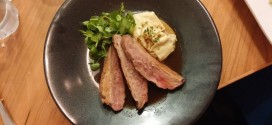By Jenny Chen
 When both of Sharon Wong’s sons were diagnosed with severe nut allergies she thought they wouldn’t be able to Asian food forever. Asian food often contains peanuts in the form of peanut oil, peanut sauce, or just crushed peanuts. Wong’s youngest son couldn’t even be in the same room as peanuts without throwing up. But the author of the popular food blog, nutfreewok.com, got inventive and she came up with several recipes for Asians that doesn’t involve any nuts at all (she shares one with us below!)
When both of Sharon Wong’s sons were diagnosed with severe nut allergies she thought they wouldn’t be able to Asian food forever. Asian food often contains peanuts in the form of peanut oil, peanut sauce, or just crushed peanuts. Wong’s youngest son couldn’t even be in the same room as peanuts without throwing up. But the author of the popular food blog, nutfreewok.com, got inventive and she came up with several recipes for Asians that doesn’t involve any nuts at all (she shares one with us below!)
Although data generally show that a larger percentage of white Americans have food allergies, research suggests that Asian Americans and black American children are more likely to have food allergies than white children are but that white children are more likely to have theirs confirmed by diagnosis according to a 2011 CNN report titled “Study: Food allergies more common, more severe among children.”
There are many reasons why food allergies might be underreported in the Asian American community – Asians may be less familiar with food allergies in general and are less likely to get tested or to advocate for food allergy safety for children in schools. “One of my relatives says that every time she eats a certain food she feels a swelling in her throat and I told her she should get tested,” Wong said. “But she said ‘It’s fine, as long as I don’t eat that food.'” Furthermore, Asians in Asia have a much lower rate of allergies than Asians born and raised in the United States. The most common allergies in children in Asia include egg allergies and cow’s milk allergies while nut allergies are virtually nonexistent, according to a report from the American Academy of Allergy, Asthma, and Immunology. Because of this, many Asian Americans may not be accustomed to looking out for food allergies in their children.
There are certain things parents should look for when it comes to food allergies, says Wong. “Children don’t know words like anaphylaxis, or allergies,” she said. “But they might say ‘This tastes spicy’ or ‘my tongue feels weird.'” They may also feel extremely sleepy after a meal for no reason or younger children may pull at their ears and suddenly become extremely distressed. Celiac’s disease is also an auto-immune response but it is different from wheat allergies. Celiac’s disease does not cause anaphylaxis but does make it impossible for the body to digest gluten (a protein found in wheat). For some allergies like wheat allergy, symptoms might take a day or two to appear. If children have stomachaches or severe diarrhea.
Wong says that family history is also correlated to food allergies. If a family member has asthma, eczema, or food allergies, your child may also be at risk for food allergies. However, the cause of food allergies are still not known. The number of kids with food allergies went up 18 percent from 1997 to 2007, according to the U.S. Centers for Disease Control and Prevention. About 3 million children younger than 18 had a food or digestive allergy in 2007, the CDC said. There are a couple theories pointing to the cause of rising food allergies among children: one is the hygiene hypothesis which argues that extreme cleanliness is our society has left our children with weak immune systems. Another theory that is gaining support argues epigenetics may be involved in the development of food allergies. Epigenetics is the study of how environmental factors affect changes at the cellular level.
Regardless of whether or not you have food allergies, it’s important to be informed and educated, says Wong. If you suspect that your child has food allergies. The doctor may ask your child to go through an elimination diet or to do an allergy skin test.
For Wong and her family, food allergies have been challenging, particularly when eating out. Wong and her husband often go to a restaurant on a night out first to test it out and see if it’s allergen-friendly. They might go back and test it another time before bringing their sons. But as Wong documents on her blog, a life of food allergies isn’t necessarily a restricted life. You just have have to be prepared and well aware.
Chicken Pineapple Fried Rice Recipe
Reprinted with permission from www.nutfreewok.com
Flashback to 14 years ago, my husband and I enjoy a date night at a Thai restaurant and one of the dishes we order is Pineapple Fried Rice. Besides being delicious, the presentation is memorable: the fried rice is served in a pineapple bowl, a pineapple cut lengthwise with the flesh scooped out, complete with the leafy top. It’s so beautifully presented and delicious but not something my children can safely enjoy as Thai restaurants are off-limits.
Due to limitations of what I had on hand and food allergies, I very loosely adapted a recipe from Rasa Malaysia which includes instructions for using eggs. Just so you know, a more traditional recipe might contain eggs, shrimp, cashews, fish sauce and some spices that would take some effort to find allergen free. I think this impromptu adaptation was pretty good and I love the sweet and sour flavors from the pineapple. A little bit of Red Boat fish sauce next time will give it quite an authentic taste.
Chicken Pineapple Fried Rice Recipe
Ingredients
1 tablespoon olive oil
2 garlic cloves, minced
¼ cup chopped onions
1 cup chopped carrots (I used baby carrots to save time)
5 broiled chicken thighs, chopped
2 cups chopped pineapple
4 cups cooked brown rice
1½ tablespoon soy sauce (or alternative)
Salt and pepper to taste
Instructions
Heat up a frying pan or wok on medium high heat (about 5 minutes).
Add olive oil, minced garlic and chopped onion, saute until fragrant (1 minute).
Add chopped carrots, chicken, and pineapple saute until the carrots are softened (5 minutes).
Add the rice, breaking up any large clumps of rice.
Add soy sauce and stir fry until everything is heated through (3 minutes).
Adjust seasoning to taste and serve immediately.
 Asian Fortune Your source for all things Asian American
Asian Fortune Your source for all things Asian American




